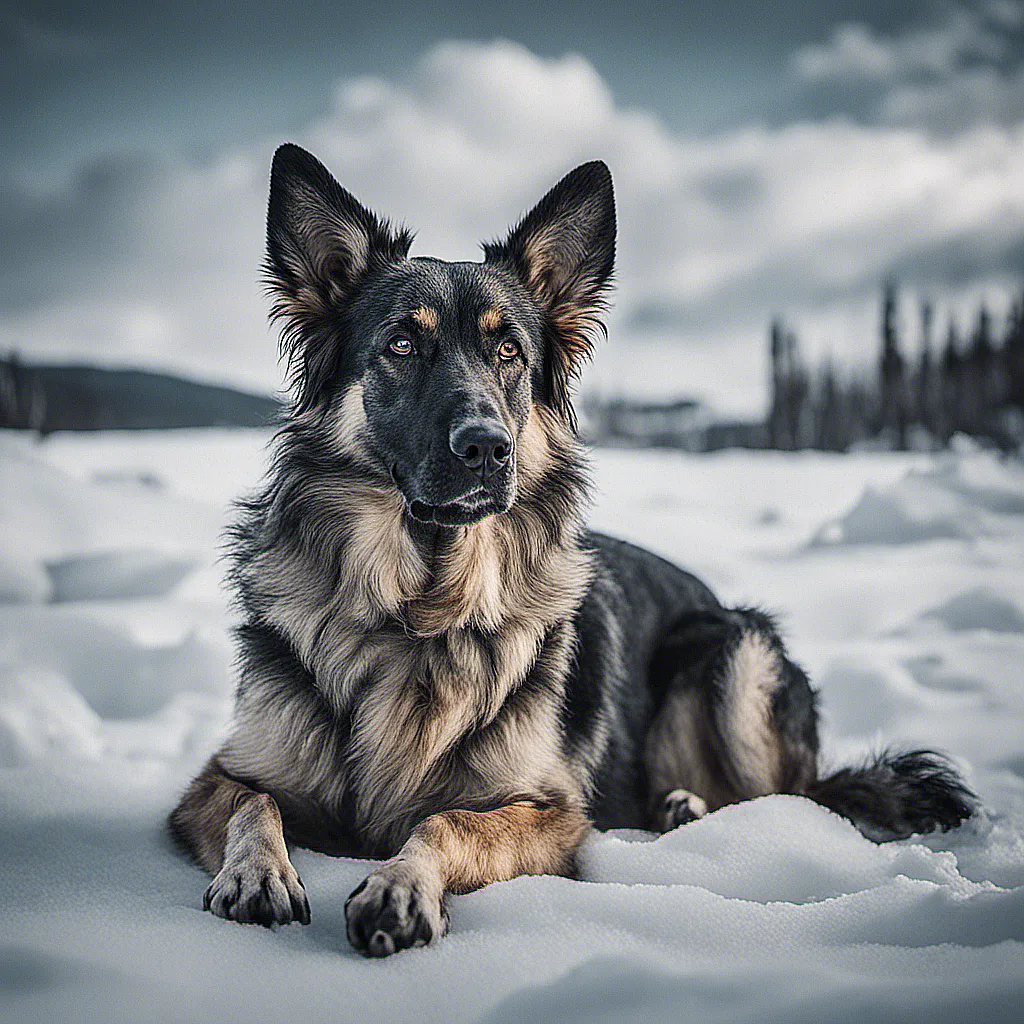In the realm of working dog breeds, two names stand out prominently; the German Shepherd and the East European Shepherd.
As an expert, I’ve gleaned extensive knowledge about these two breeds, their unique characteristics, and performance abilities.
The fascination of German Shepherd and East European Shepherd
At first glance, both the German Shepherd and the East European Shepherd may seem quite similar due to their shared lineage. However, they are distinctly unique breeds, each demonstrating different capabilities and attributes.
The German Shepherd is rightly famed for its intelligence, agility, versatility, and formidable working abilities, leading to its widespread use in jobs as diverse as police work, search and rescue, and disability assistance.
The East European Shepherd, on the other hand, is an engaging blend of elegance, strength, and exceptional endurance.
Initially developed for military work, it’s highly adapted to harsh weather conditions and demanding tasks, making it a stalwart companion for those needing a sturdy, reliable working dog.
Understanding the differences between the two breeds
While both breeds offer remarkable attributes, there are notable differences. The German Shepherd shows a balance of speed and power, exemplified by its more compact build and sharp agility.
Contrarily, the East European Shepherd is slightly larger and built more for endurance than speed, reflecting in its powerful build and adaptation to rigorous conditions.
User-friendly comparison chart:
| German Shepherd | East European Shepherd |
|---|---|
| High speed and agility | High endurance |
| Compact build | Larger frame |
| Adaptable to diverse roles | Best suited for rigorous tasks |
| Adaptable to moderate climates | Adapted to very tough climates |
In choosing between these two distinct breeds, the decision hinges largely on individual needs and environmental factors.
Characteristics and Traits
As a dog enthusiast, I find the nuances between different breeds fascinating. Today, I will focus on two breeds, East European Shepherd and German Shepherd.
Some points of differentiation between those two magnificent breeds include physical attributes and differences in behavior.

1. Physical attributes and appearance
Originating in the 20th Century, the Russian breed East European Shepherd are larger than their German counterparts. In terms of size, males can reach up to 30 inches in height and around 110 pounds in weight, making them among the largest in the Shepherd family.
They possess a dense double coat, large heads, and an impressively muscular structure. Their physical stature is their distinct characteristic, making them a common choice for military and police work.
Contrastingly, the German Shepherds, originated in Germany in the late 19th century, stand at around 26 inches for males and weigh up to 90 pounds. Built for stamina, they exhibit a nimble, athletic build. Their double coat is less dense, and they possess a more streamlined body structure.
2. Behavioral differences and temperaments
The East European Shepherd are specifically bred for their working capabilities, inherently, they are intelligent, determined, and often aloof towards strangers. A strikingly loyal breed, they need consistent training and socialization from a young age.
On the other hand, German Shepherds are hailed for their intelligence, protective nature, and versatility. They are highly trainable and used worldwide for various roles, including disability assistance, search-and-rescue, and police and military roles.
At the end of the day, individual dog temperaments can vary, and both breeds can make exceptional pets in the right environment.
Training and Intelligence
As an Expert in the field, I often get to work with diverse breeds, each possessing unique traits. Two breeds especially remarkable for their intelligence and trainability are the German Shepherds and the East European Shepherds.
1. Trainability and learning capabilities of German Shepherds
Over the years, I’ve consistently seen that the German Shepherd breed excels in training due to its outstanding intelligence and eagerness to learn.
Known for its ability to understand complex commands, the German Shepherd is truly second to none when it comes to learning new tasks – an attribute that has made it a beloved choice for roles such as police and service dogs.
Famed for their diligence and keen problem-solving abilities, they are inherently adaptable and able to grasp complex commands swiftly.
2. Unique Intelligence and stubbornness of East European Shepherds
East European Shepherds are commendably smart as well but display a unique blend of stubbornness which reflects their intense loyalty and protective instincts.
Their stubbornness, which might initially appear as a training challenge, is essentially a demonstration of their strong-willed nature and exceptional resolve.
It is worth noting that this specific breed tends to take commands more seriously from a handler they respect. Therefore, effective training requires establishing a deep connection and a command-respect bond with the East European Shepherd.
In essence, both breeds, while displaying different traits, are sterling examples of canine intelligence and loyalty.
Their trainability varies based on their innate characteristics, but both breeds have a high potential for learning and task performance.
History and Origins

Examining the roots and development of dog breeds provides vital insight into their character, capabilities, and suitability for various roles.
Focusing primarily on the German Shepherd and East European Shepherd, we see two breeds with different origins and intentions, yet sharing a common link.
1. Origins of German Shepherds and their development
Conceived in the late 19th century, the German Shepherd boasts a long history that speaks volumes about its innate abilities.
An ambitious German cavalry officer, Max von Stephanitz, aimed to refine local shepherd dogs into a distinctive working breed.
The result was the active, intelligent, and versatile German Shepherd, a breed associated with traits such as versatility, strength, and obedience.
As a serious working dog, it gained popularity, particularly for its utility in police and military operations.
2. Creation of East European Shepherds and their purpose
Tracing back to post-WWII, the creation of the East European Shepherd was a result of the USSR’s pursuit of a larger, resilient breed to perform in their military and police forces.
The East European Shepherd, a descendant of German Shepherds chosen for their size and power, was bred selectively to withstand the harsh Siberian winters.
Notably, East European Shepherds possess a robust structure and a calm yet vigilant demeanor, making them highly suitable for guarding roles and search duties.
While these breeds reveal a shared ancestry, their evolution diverged to serve different purposes, influenced by geographical location and respective environmental conditions.
Understanding these differences highlights the unique charm and utility of each of these exceptional shepherd breeds.
Benefits and Considerations
As an experienced dog enthusiast, I can attest that both East European Shepherds and German Shepherds are truly magnificent breeds.
Both breeds exhibit exceptional traits and characteristics, making them worthy companions.
1. Suitability for different lifestyles and environments
East European Shepherds are known for their tenacity and physical strength, making them an excellent choice for active individuals living in colder climates. They have a resilient nature and adapt well to tasks that require endurance.
On the other hand, German Shepherds are renowned for their versatility and intelligence. They are perfect for families or individuals leading an active lifestyle in any climate.
Their strong bonding ability with their owners makes them fabulous companions and family pets.
2. Factors to consider when choosing between the two breeds
One important factor is the difference in health issues between the two breeds. East European Shepherds are prone to hip and elbow dysplasia, while German Shepherds often encounter similar health problems, in addition to potential skin allergies.
Secondly, their coats differ. East European Shepherds have thicker, longer fur, ideal for cold places, whereas German Shepherds have a medium-length double coat adaptable to various climates.
Finally, the temperament between the two breeds is noticeable. While both breeds are known for their loyalty, German Shepherds are often more curious and outgoing compared to East European ones, which maybe a bit wary with strangers.
Health and Care
As a dedicated shepherd dog owner, it’s vital to recognize that these breeds have particular health and care needs. From the well-beloved German Shepherd to the robust East European Shepherd, these canine companions bring immense joy and utility, but they also have specific health concerns that demand attention and care.
Common health issues in German Shepherds
Being the owner of a German Shepherd, I’ve found it necessary to stay vigilant for specific health issues typically associated with the breed. A prevalent condition among German Shepherds is hip and elbow dysplasia, a genetic issue that often comes about with age and can limit the mobility and vitality of your dog.
Another common health issue in German Shepherds is Degenerative Myelopathy, a severe neurological disease, likened to human Multiple Sclerosis or ALS, that affects the spinal cord, causing progress immobility starting with the hind legs.
Maintaining the health and well-being of East European Shepherds
On the other hand, my experience with owning an East European Shepherd has taught me about other breed-specific health conditions. Similar to German Shepherds, these dogs also face issues like hip dysplasia. Other common issues include bloating and obesity. Proper diet & exercise interventions are critical for managing these problems.
Finally, it’s essential to note that East European Shepherds require regular mental and physical stimulation, given their working-dog heritage and high intelligence levels. Providing them with enough play, puzzles, and active time is critical to their overall happiness and well-being.
Conclusion
Throughout this discourse on the German Shepherd and East European Shepherd, I have investigated the unique characteristics, temperament, and other aspects of the two breeds. It’s now time to pull all of this information together and draw some conclusions.
1. Making an informed decision: German Shepherd or East European Shepherd?
One cannot state definitively that one breed is superior to the other. It all boils down to individual preferences, lifestyle, and living conditions. The German Shepherds are known for their strong constitution, ability to work in various capacities from police dogs to family pets, and they’re very reliable and trainable.
On the other hand, the East European Shepherds, while similar to their German cousins, are much larger and require a lot more exercise. They have been predominantly used for working purposes given their strength and endurance.
2. Final thoughts and recommendations
If an active lifestyle and robust companion align with your requirements, the East European Shepherd would be a perfect fit. Conversely, if you are more inclined toward a smaller sized, yet equally smart and reliable companion, the German Shepherd would cater to your preferences.
To ensure happiness and health for both you and your four-legged companions, aligning the breed characteristics with your lifestyle is a key factor. Aside from that, every dog, regardless of breed, requires adequate care, attention, and above all, love.
In the end, the decision rests solely in your hands and I am confident that with these insights, you are fully equipped to make a well-informed decision about the breed that suits you best.

